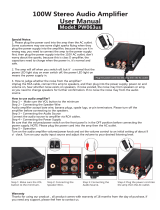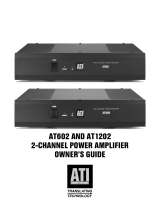Parasound ZoneMaster 2350 Owner's manual
- Category
- Audio amplifiers
- Type
- Owner's manual
This manual is also suitable for
Parasound ZoneMaster 2350 is a versatile two-channel amplifier with a sub crossover, ideal for powering multiple speakers or subwoofers in various configurations. Connect your audio sources and speakers, and adjust the channel level controls to achieve the desired balance. Use the high pass filter to fine-tune the sound for your speakers, and the A/B speaker selector lockout switch to prevent accidental speaker changes.
Parasound ZoneMaster 2350 is a versatile two-channel amplifier with a sub crossover, ideal for powering multiple speakers or subwoofers in various configurations. Connect your audio sources and speakers, and adjust the channel level controls to achieve the desired balance. Use the high pass filter to fine-tune the sound for your speakers, and the A/B speaker selector lockout switch to prevent accidental speaker changes.




















-
 1
1
-
 2
2
-
 3
3
-
 4
4
-
 5
5
-
 6
6
-
 7
7
-
 8
8
-
 9
9
-
 10
10
-
 11
11
-
 12
12
-
 13
13
-
 14
14
-
 15
15
-
 16
16
-
 17
17
-
 18
18
-
 19
19
-
 20
20
Parasound ZoneMaster 2350 Owner's manual
- Category
- Audio amplifiers
- Type
- Owner's manual
- This manual is also suitable for
Parasound ZoneMaster 2350 is a versatile two-channel amplifier with a sub crossover, ideal for powering multiple speakers or subwoofers in various configurations. Connect your audio sources and speakers, and adjust the channel level controls to achieve the desired balance. Use the high pass filter to fine-tune the sound for your speakers, and the A/B speaker selector lockout switch to prevent accidental speaker changes.
Ask a question and I''ll find the answer in the document
Finding information in a document is now easier with AI
Related papers
-
Parasound ZoneMaster 2 Owner's manual
-
Parasound ZoneMaster 4 Owner's manual
-
Parasound ZoneMaster 12 Owner's manual
-
Parasound Zpre3 Owner's manual
-
Parasound ZoneMaster 250 Owner's manual
-
Parasound ZoneMaster Model 450 Owner's manual
-
Parasound HALO JC 1 User manual
-
Parasound 275 User guide
-
Parasound 275-V2 User manual
-
Parasound Halo P 3 User manual
Other documents
-
Crystorama 587-SA Operating instructions
-
 Neoteck NTKPW063us-US User guide
Neoteck NTKPW063us-US User guide
-
Laser SPK-Q14PBD User manual
-
Rockville DBM45 Owner's manual
-
RocketFish RF-SSVC6 Quick setup guide
-
Halo A 21 Owner's manual
-
OSD Audio TSM8 Owner's manual
-
Episode EA-MR-AW-RVC-100 Owner's manual
-
Monoprice 118513 User manual
-
 Amplifier Tech AT602 User manual
Amplifier Tech AT602 User manual





















